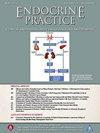Rituximab Treatment as Second-Line Therapy in Glucocorticoid Nonresponsive Graves' Orbitopathy: A Nonrandomized, Controlled, Interventional Study
IF 4.6
3区 医学
Q2 ENDOCRINOLOGY & METABOLISM
引用次数: 0
Abstract
Objective
In moderate-to-severe Graves' orbitopathy, rituximab is recommended as second-line therapy in patients nonresponsive to intravenous glucocorticoids. We aimed to evaluate rituximab as early second-line therapy, as data are scarce and contradictory.
Methods
In this nonrandomized, controlled, interventional study, patients with Graves' orbitopathy started on intravenous glucocorticoids. After 4 weeks, patients with < 2 points improvement in clinical activity score (CAS) were switched to rituximab [Non-Responders Rituximab (NR-RTX) group] and were compared to the remaining patients who continued with intravenous glucocorticoids for 12 weeks [Responders-Glucocorticoid (R-GC) group]. A retrospective group of non-responsive patients who were provided regular care with intravenous glucocorticoids for 12 weeks was used as control [Non-Responders-Regular Care group]. Background data and CAS were recorded for all groups at 0, 4, 12, 18, and 68 weeks. Quality of life (QoL) and safety data were collected from the NR-RTX and R-GC groups.
Results
The NR-RTX group (n = 12) was similar to the others at baseline except for a 1-point lower median CAS compared to the NR-RC group (n = 12) (P = .03), and for having twice as many men compared to the R-GC group (n = 13) (P = .03). At 4 weeks, a linear mixed model indicated that the R-GC group had a 1.21-point (95% CI: −2.40 to −0.02) lower value for CAS compared to the NR-RTX group. CAS for all groups converged over time. Similar models for QoL revealed no treatment or time effects.
Conclusion
Switch to RTX early in the treatment course did not result in better CAS or QoL, compared to continuous intravenous glucocorticoids.

利妥昔单抗作为糖皮质激素无反应性Graves眼病的二线治疗:一项非随机、对照、介入性研究。
目的:对于中重度巴塞杜氏眼病(Graves's orbitopathy,GO),建议将利妥昔单抗作为静脉注射糖皮质激素无效患者的二线疗法。我们的目的是评估利妥昔单抗作为早期二线疗法的效果,因为相关数据很少且相互矛盾:在这项非随机、对照、干预性研究中,GO 患者开始静脉注射糖皮质激素。4周后,GO患者开始接受NR-RTX治疗:NR-RTX组(n=12)在基线时与其他组相似,但与NR-RC组(n=12)相比,CAS中位数低1分(P=0.03),与R-GC组(n=13)相比,男性患者人数多一倍(P=0.03)。线性混合模型显示,4 周时,R-GC 组的 CAS 值比 NR-RTX 组低 1.21 点(95%CI:-2.40 至-0.02)。随着时间的推移,各组的 CAS 值趋于一致。类似的QoL模型显示没有治疗或时间效应:结论:与持续静脉注射糖皮质激素相比,在疗程早期改用 RTX 并不能改善 CAS 或 QoL。
本文章由计算机程序翻译,如有差异,请以英文原文为准。
求助全文
约1分钟内获得全文
求助全文
来源期刊

Endocrine Practice
ENDOCRINOLOGY & METABOLISM-
CiteScore
7.60
自引率
2.40%
发文量
546
审稿时长
41 days
期刊介绍:
Endocrine Practice (ISSN: 1530-891X), a peer-reviewed journal published twelve times a year, is the official journal of the American Association of Clinical Endocrinologists (AACE). The primary mission of Endocrine Practice is to enhance the health care of patients with endocrine diseases through continuing education of practicing endocrinologists.
 求助内容:
求助内容: 应助结果提醒方式:
应助结果提醒方式:


